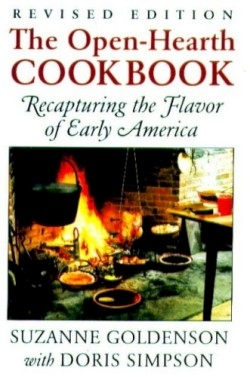The Open-Hearth Cookbook
Recapturing the Flavor of Early America
In recent years there has been a resurgence of interest in early American cooking, fueled, ironically, by advances in technology. Online digital projects such as Feeding America at Michigan State University have made it possible for people to examine eighteenth- and nineteenth-century cookbooks without having to invest a fortune with rare book dealers. But curious cooks who would like to reproduce some of the recipes in those culinary artifacts face many problems, not the least of which is that while the modern kitchen may have Cuisinarts and Kitchen Aids, it is unlikely to have cooking andirons, or a “tin kitchen,” or an eight- to ten-foot-wide fireplace. Our great-great-grandmothers simply cooked differently than we do.
The strength of this book is that it is more a cultural history of early American cooking than a collection of recipes. In fact, about two-thirds of the book is devoted to explanations of the tools and process of cooking in early America. A tin kitchen, by the way, was “a cylindrical tin box, open on one side, which sat in front of fire. Its shiny surfaces reflected the fire’s heat onto the sides of the food not directly facing the fire.”
But The Open-Hearth Cookbook is not intended to be just a resource for the culinary anthologist and historian. The authors want their readers to experience the pleasures of cooking the old-fashioned way. “Food cooked in a fireplace tastes marvelous,” they exclaim, “better than food cooked in most conventional ways today—the charcoal barbeque included.” Goldenson was a Princeton, NJ-based restaurant critic for more than twenty years, and the founder and president of Golden Sun Books, a publisher of New Jersey-interest books. Simpson, co-owner of a restaurant, once helped cook a Thanksgiving dinner over an open hearth for Craig Claiborne.
The authors begin with the basics: how to acquire wood and build a fire that is more appropriate for cooking than for cuddling in front of. They explain how to season cast-iron cookware and why it should be done. They detail the processes of our ancestors and how they can be adapted to the modern kitchen, such as this tip for baking in a Dutch oven. “The modern housewife may want to stash some maple leaves in her freezer instead of hanging them from her ceiling, as we find this preserves them better. Although not as charming as maple leaves, several layers of brown paper cut from grocery bags to fit the oven’s bottom and greased will also serve to line the Dutch oven effectively.”
The modern cook (not just the “modern housewife,” a phrase that pops up with bewildering frequency in this book) will surely learn something about cooking with this book, which is a revised edition of a volume originally published in 1982. The authors cite statistics from 1978 about the growing numbers of fireplaces and wood stoves in American homes, a figure that decades ago lost its relevancy. Nevertheless, The Open-Hearth Cookbook provides a tasty sampling of how America used to cook.
Reviewed by
Erik Bledsoe
Disclosure: This article is not an endorsement, but a review. The publisher of this book provided free copies of the book to have their book reviewed by a professional reviewer. No fee was paid by the publisher for this review. Foreword Reviews only recommends books that we love. Foreword Magazine, Inc. is disclosing this in accordance with the Federal Trade Commission’s 16 CFR, Part 255.

